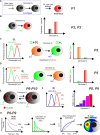Imaging of oxygen and hypoxia in cell and tissue samples
- PMID: 29761206
- PMCID: PMC11105559
- DOI: 10.1007/s00018-018-2840-x
Imaging of oxygen and hypoxia in cell and tissue samples
Abstract
Molecular oxygen (O2) is a key player in cell mitochondrial function, redox balance and oxidative stress, normal tissue function and many common disease states. Various chemical, physical and biological methods have been proposed for measurement, real-time monitoring and imaging of O2 concentration, state of decreased O2 (hypoxia) and related parameters in cells and tissue. Here, we review the established and emerging optical microscopy techniques allowing to visualize O2 levels in cells and tissue samples, mostly under in vitro and ex vivo, but also under in vivo settings. Particular examples include fluorescent hypoxia stains, fluorescent protein reporter systems, phosphorescent probes and nanosensors of different types. These techniques allow high-resolution mapping of O2 gradients in live or post-mortem tissue, in 2D or 3D, qualitatively or quantitatively. They enable control and monitoring of oxygenation conditions and their correlation with other biomarkers of cell and tissue function. Comparison of these techniques and corresponding imaging setups, their analytical capabilities and typical applications are given.
Keywords: FLIM; Fluorescence and phosphorescence-based probes; Fluorescence microscopy; Hypoxia; Live cell and tissue imaging; Oxygen microscopy; PLIM.
Conflict of interest statement
D.B.P. is a former stakeholder of Luxcel Biosciences (now part of Agilent). R.I.D. has no conflicts of interests.
Figures

Similar articles
-
Imaging of neurosphere oxygenation with phosphorescent probes.Biomaterials. 2013 Dec;34(37):9307-17. doi: 10.1016/j.biomaterials.2013.08.065. Epub 2013 Sep 6. Biomaterials. 2013. PMID: 24016849
-
Multi-Parametric Imaging of Hypoxia and Cell Cycle in Intestinal Organoid Culture.Adv Exp Med Biol. 2017;1035:85-103. doi: 10.1007/978-3-319-67358-5_6. Adv Exp Med Biol. 2017. PMID: 29080132
-
Imaging of oxygen gradients in giant umbrella cells: an ex vivo PLIM study.Am J Physiol Cell Physiol. 2015 Oct 1;309(7):C501-9. doi: 10.1152/ajpcell.00121.2015. Epub 2015 Aug 5. Am J Physiol Cell Physiol. 2015. PMID: 26246428
-
Phosphorescence based O2 sensors - Essential tools for monitoring cell and tissue oxygenation and its impact on metabolism.Free Radic Biol Med. 2016 Dec;101:202-210. doi: 10.1016/j.freeradbiomed.2016.09.018. Epub 2016 Oct 24. Free Radic Biol Med. 2016. PMID: 27789291 Review.
-
Optical Probes for Neurobiological Sensing and Imaging.Acc Chem Res. 2018 May 15;51(5):1023-1032. doi: 10.1021/acs.accounts.7b00564. Epub 2018 Apr 13. Acc Chem Res. 2018. PMID: 29652127 Free PMC article. Review.
Cited by
-
Bifunctional Temperature and Oxygen Dual Probe Based on Anthracene and Europium Complex Luminescence.Int J Mol Sci. 2022 Nov 22;23(23):14526. doi: 10.3390/ijms232314526. Int J Mol Sci. 2022. PMID: 36498852 Free PMC article.
-
Oxygen dynamics and delivery strategies to enhance beta cell replacement therapy.Am J Physiol Cell Physiol. 2025 May 1;328(5):C1667-C1684. doi: 10.1152/ajpcell.00984.2024. Epub 2025 Apr 9. Am J Physiol Cell Physiol. 2025. PMID: 40204281 Free PMC article. Review.
-
Allometric Scaling of physiologically-relevant organoids.Sci Rep. 2019 Aug 15;9(1):11890. doi: 10.1038/s41598-019-48347-2. Sci Rep. 2019. PMID: 31417119 Free PMC article.
-
Luminescence lifetime imaging of three-dimensional biological objects.J Cell Sci. 2021 May 1;134(9):1-17. doi: 10.1242/jcs.254763. Epub 2021 May 7. J Cell Sci. 2021. PMID: 33961054 Free PMC article.
-
Mapping O2 concentration in ex-vivo tissue samples on a fast PLIM macro-imager.Sci Rep. 2020 Nov 4;10(1):19006. doi: 10.1038/s41598-020-75928-3. Sci Rep. 2020. PMID: 33149165 Free PMC article.
References
Publication types
MeSH terms
Substances
Grants and funding
LinkOut - more resources
Full Text Sources
Other Literature Sources

